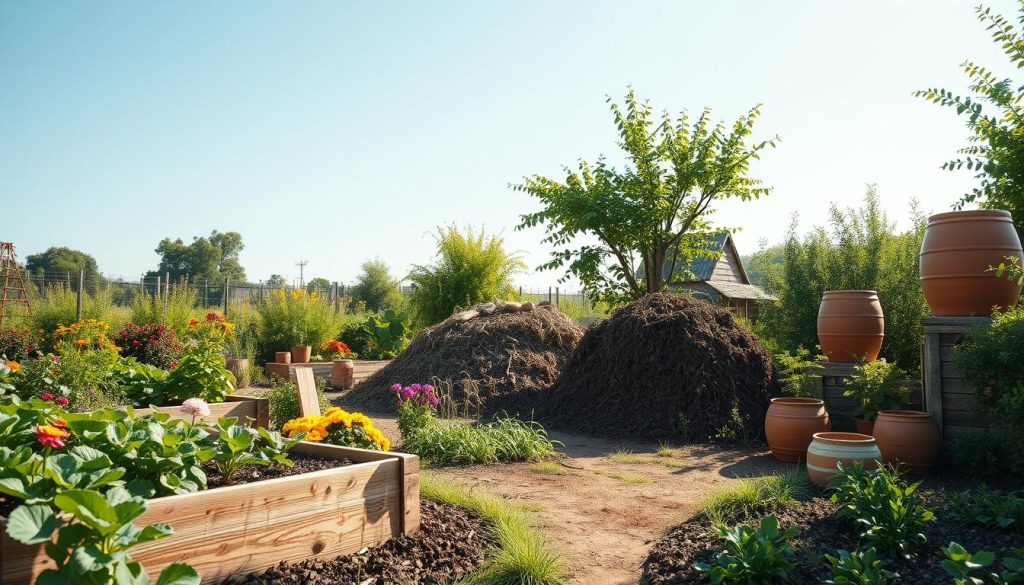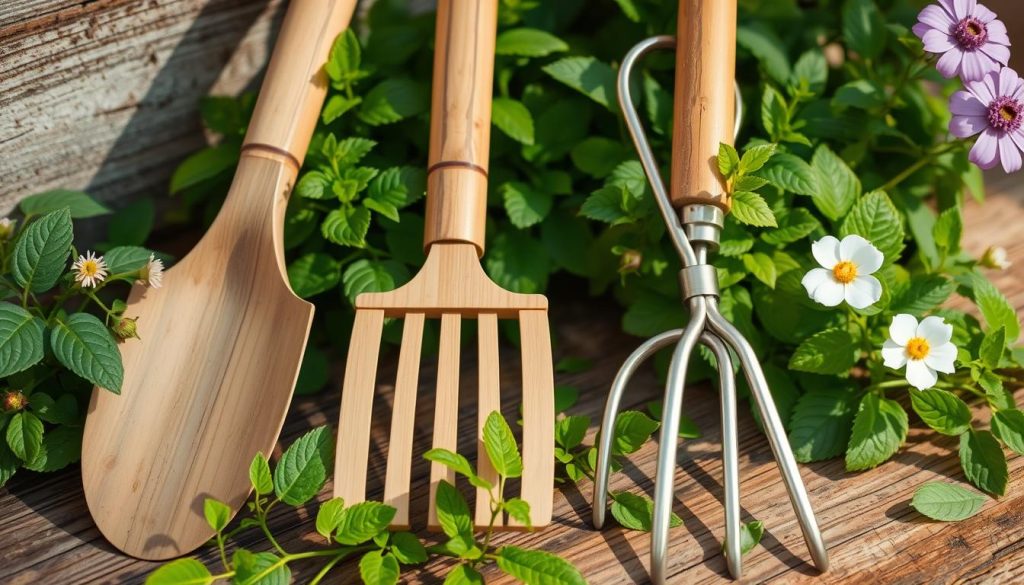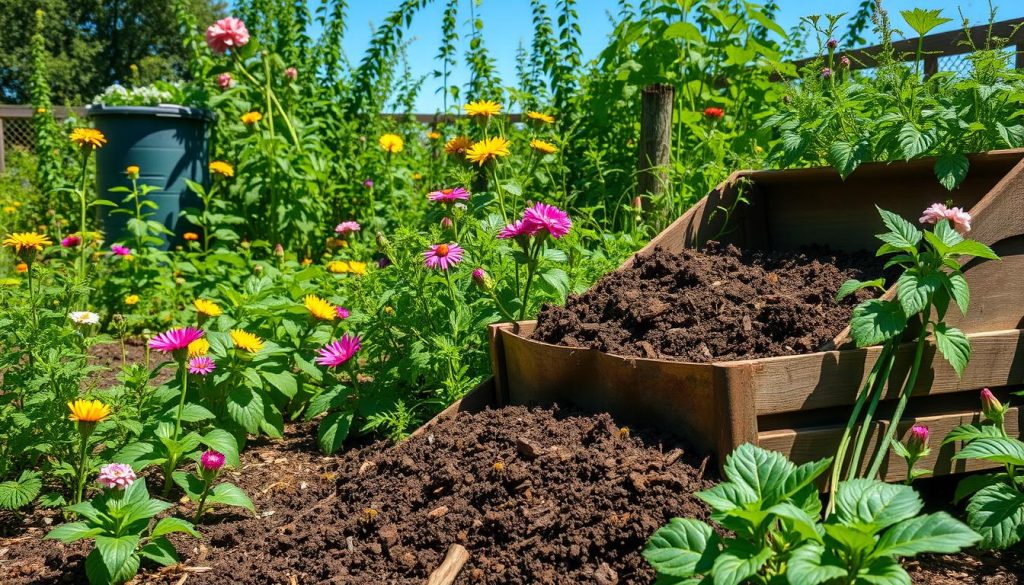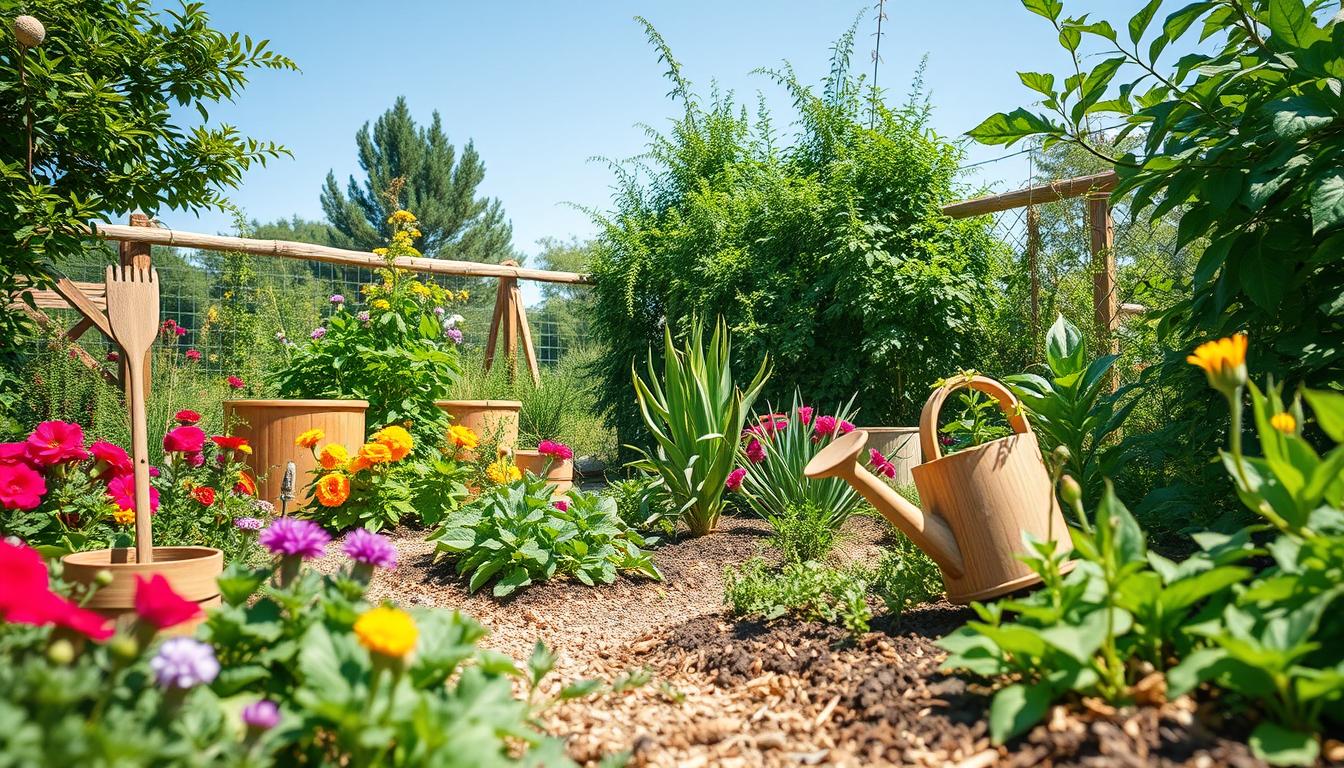I’m excited to share my journey to plastic-free gardening. I’ve learned to reduce waste and promote sustainability in my garden. By choosing sustainable practices, we can make a big difference and create a healthier garden.
Exploring plastic-free gardening has shown me many benefits. It helps reduce plastic waste and makes our gardens more balanced. I’ll share my top tips to help you start your sustainable gardening journey.
Switching to plastic-free gardening is good for the environment and our gardens. It makes our gardens full of life and free from harmful chemicals. In this article, I’ll share how to add eco-friendly and sustainable practices to your gardening routine.
Understanding the Impact of Plastic in Gardening
Exploring gardening, I’ve seen how plastic harms our environment. Plastic in gardening damages soil, wildlife, and ecosystems. Zero-waste gardening helps cut down plastic waste in our gardens and the environment.
Plastic in gardening hurts local wildlife. Animals can eat plastic, leading to health issues and death. It also pollutes soil, harming plant growth and ecosystem health. Organic gardening methods make our gardens healthier and safer for plants and soil.
Why Go Plastic-Free?
Choosing eco-friendly gardening is key for a healthy garden. Going plastic-free offers many benefits:
- Less plastic waste in landfills and oceans
- Conservation of natural resources
- Healthy plant growth with organic gardening
The Environmental Consequences of Plastic Waste
Plastic waste in gardening has big environmental problems. It takes centuries to break down and harms the environment. Zero-waste gardening reduces plastic waste, helping our planet.

Essential Tools for Plastic-Free Gardening
To start a plastic-free garden, you need the right tools. As a gardener, I’ve found that using durable, eco-friendly tools is key. Choosing tools made from natural materials like bamboo and natural fibers helps us avoid plastic.
Having the right tools is just the start. Here are some must-haves for beginners:
- Bamboo gardening gloves for protection and grip
- Natural fiber twine for plant support and training
- Compost bins made from recycled materials for sustainable waste management
- Eco-friendly watering cans made from natural materials, such as copper or clay
Using these tools helps us adopt natural gardening methods. It also reduces our environmental impact. Every small change helps, and starting with the right tools is a great first step.

Composting: A Key to Sustainability
Exploring plastic-free gardening, I’ve learned composting’s big role. It makes gardening better for the planet. Composting cuts down waste and enriches soil, making gardens healthier.
To start composting, you need a few things. You’ll need a bin, brown stuff like leaves, and green stuff like food scraps. Here’s how to begin:
- Find a spot for your bin that’s airy and easy to get to
- Mix brown and green materials in your bin, aiming for 2/3 brown to 1/3 green
- Keep the bin damp and turn the mix often to help it break down
Composting is a key part of green gardening. It boosts soil health and cuts down on chemical fertilizers. Starting to compost is a great way to help the planet.

Plastic-Free Pest Control Methods
My journey to a plastic-free garden has shown me the value of natural pest control. Using green gardening tips and earth-friendly ideas, I’ve cut down on plastic pest control. Now, my garden is healthier and more sustainable.
Controlling pests naturally is key. Neem oil fights off many pests, from aphids to whiteflies. Also, introducing beneficial insects like ladybugs and lacewings helps keep the ecosystem balanced. This reduces the need for harmful pesticides.
Natural Remedies That Work
- Neem oil: a natural insecticide that can be used to control a wide range of pests
- Diatomaceous earth: a natural substance that can be used to control slugs and snails
- Garlic spray: a natural repellent that can be used to control aphids and other pests
Using these natural remedies and green gardening ideas has balanced my garden’s ecosystem. This approach lowers my environmental impact and makes my garden healthier and sustainable.
Attracting Beneficial Insects
Attracting beneficial insects is crucial for plastic-free pest control. By planting lavender and marigold, I’ve drawn in helpful insects. This strategy reduces my environmental footprint and makes my garden healthier and sustainable.
Creating a Plastic-Free Garden Bed
I’m on a mission to make my garden sustainable. Building a plastic-free garden bed is key. It cuts down on waste and supports green gardening. By doing this, I help my plants grow in a healthier environment.
There are many ways to make a garden bed. You can use reclaimed wood, bamboo, or recycled plastic lumber. These materials are strong and eco-friendly. Here are some choices:
- Reclaimed wood: It makes a unique, rustic bed. Plus, it’s a smart way to reuse old wood.
- Bamboo: It’s a top pick for garden beds. Bamboo is strong, light, and easy to care for.
- Recycled plastic lumber: It’s ideal for a low-care bed. Made from recycled plastic, it resists rot and pests.
I also use organic mulch to keep the soil moist and weed-free. This choice is good for the planet and my garden. Straw, bark chips, and grass clippings work well. They help my garden grow strong and green.
Water Conservation in a Plastic-Free Garden
Exploring plastic-free gardening, I’ve learned about water conservation. It’s key to a sustainable garden. Practices like rainwater harvesting and drip irrigation help a lot. They reduce our environmental impact and keep gardens healthy.
Here are some natural ways to save water in your garden:
- Collecting rainwater in barrels or tanks for irrigation
- Using drip irrigation systems made from clay or bamboo
- Mulching with organic materials to keep soil moist
Using these methods, my garden becomes more sustainable and eco-friendly. It’s good for the environment and saves money on water. These techniques help me enjoy a lush garden while caring for our planet.
My Favorite Plastic-Free Gardening Resources
I’ve shared my journey to a moreplastic-free gardeningway of life. I wanted to share some of my favorite resources with you. These books, online guides, and local workshops will inspire and inform you, whether you’re starting or deepening youreco-friendly gardeningknowledge.
Books and Online Guides
“The Vegetable Gardener’s Bible” by Edward C. Smith and “The Organic Gardener’s Handbook” by Shawna Coronado are great. They offer tips and techniques for a thriving,plastic-free garden. Online, Gardener’s Supply Company and The Old Farmer’s Almanac have lots ofeco-friendly gardeninginformation.
Local Workshops and Community Groups
Connecting with your local gardening community is key. Look for workshops by your city’s parks or environmental groups. You can learn hands-on aboutplastic-free gardeningtechniques. Joining a community garden or master gardener program is also a good idea. It lets you network and find newsustainable gardeningideas.
Using these resources will help you grow yourplastic-free gardeningknowledge. You’ll make your garden more environmentally friendly and productive. Happy growing!

